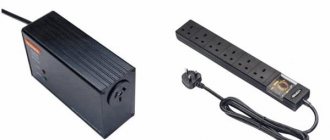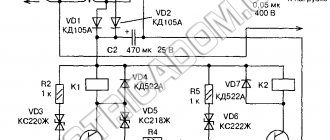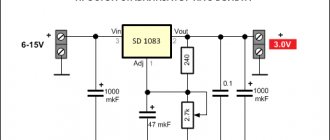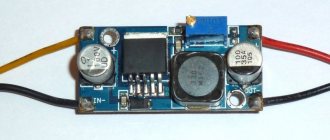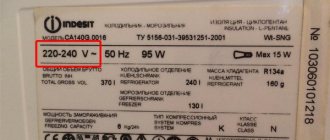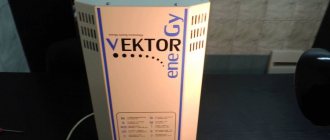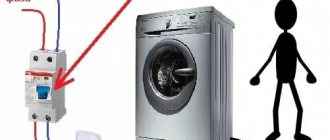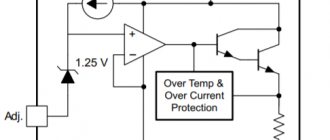When choosing a voltage stabilizer or an uninterruptible power supply, you can immediately note that these devices differ significantly in their functionality. It would also be a good idea to determine the advisability of installing one or another device near your computer, but first, let’s look at the differences between these seemingly very similar converters.
Source inelt.by
Do modern TVs need a stabilizer?
The issue of voltage stabilization for TVs has been around since the times when TVs were tube-based, and as the voltage changed, the picture on the screen was distorted. Often after such failures it was necessary to repair equipment.
All modern TVs are divided into the following main types: LED, LCD and plasma. Their peculiarity is that they are equipped with a switching power supply. Such units can operate in a fairly wide voltage range from 170 to 250 V. If such values are exceeded, the TV should turn off. If this does not happen, internal elements may burn out and then repairs will not be possible.
Some manufacturers, for example, LG and Samsung, produce specialized stabilizing devices. However, their cost significantly exceeds the cost of similar devices from other manufacturers.
And yet, is a voltage stabilizer needed for LCD or LED TVs?
If you constantly have power surges in your network, lights flash, and devices turn off, then in this case it is definitely worth installing a protective device. First you need to determine within what limits this happens. To do this, it is enough to measure the intensity level several times a day with a special tester.
Moreover, it may be better to install a stabilizing device on the entire apartment or house, which, of course, is quite expensive. But here we need to look at the circumstances. If equipment constantly has to be repaired, it is better to ensure network stabilization once, if its condition cannot be improved in any way.
The main stabilizer is installed as close as possible to the panel room, immediately after the meter
But such critical situations happen extremely rarely in urban electrical networks. This is more typical for rural areas. Therefore, there is usually no need to install a stabilization device, given its considerable cost. But if you are still worried about your equipment, but don’t know how to make a choice, it’s worth finding out what kind of stabilizing devices there are.
Another misconception is that pixels in TVs burn out due to increased voltage. Pixels are control transistors. And they can fail regardless of voltage. The same applies to a short circuit. If it does not occur in the device itself, then the power supply to the TV will simply stop, and the stabilizing device will not help in this situation. Moreover, this does not affect the operation of household appliances.
Sometimes you can come across a recommendation to purchase an uninterruptible power supply, which ensures the operation of the equipment in the event of a power outage. For TVs, this measure is not necessary at all.
Why do TVs burn during power surges?
If a person lives in a city apartment, then he is unlikely to be concerned about power surges. Therefore, many people believe that purchasing a stabilizer is a waste of money and is not needed for a modern LCD TV. But when a citizen lives outside the city in a rural area, the quality of electricity there is completely different. Frequent power surges occur there, which can become critical for any TV, even the most modern one.
For this reason, power supplies are protected in the form of a fuse, which easily melts when the set load is exceeded. Using this technology, you can leave important components of the TV out of reach if a large power surge occurs. But the safety mechanism itself will burn out, since it is disposable. And the TV will still not work until the faulty power supply is replaced. Increased voltage in the power supply of a Rolsen TV (or any other model) will lead to equipment failure. It is important to note that a burnt element cannot be restored. To prevent the TV from burning out in this way, you need to purchase a voltage stabilizer. Otherwise, the TV device will have to be constantly turned off if there is even the slightest hint of fluctuation in the network.
Does your computer need an external surge protector?
At first glance, the most reliable solution suggests itself - first a network filter that protects against interference, then a stabilizer, then an uninterruptible power supply, and only then computer equipment.
Despite all the external attractiveness of this scheme, some of its elements may turn out to be unnecessary.
Let's start with the surge protector. There is usually a varistor at the input that limits short-term high-voltage pulses. A varistor is a semiconductor element with a nonlinear current-voltage characteristic, which has a high resistance at a rated or slightly increased supply voltage, but instantly “shorts out” when a short-term jump of several kilovolts occurs.
As you can see, the operation of such a simple element as a varistor can protect expensive equipment from damage. But it is precisely the simplicity and low cost of the protection circuit with a varistor that has led to the fact that such protection is built into all computer power supplies, thereby eliminating the need to duplicate this part of the circuit with an external filter. In addition, a high-frequency noise filtering circuit with a choke and capacitors is built into the power supplies of computers and other office equipment. Only the most unscrupulous manufacturers do not install such filters.
It turns out that an additional surge filter, although it won’t hurt, won’t bring much benefit either.
Now let's talk about the stabilizer. Is it really necessary in this scheme?
Old tube TVs
The adult generation remembers very well that in the USSR under every TV there was a plastic box called a “voltage stabilizer” that was sure to hum. The box, as a rule, was hot and necessarily heavy.
Of course, TVs could work without these boxes, but any deviation of the voltage in the outlet from 220V led to the image on the screen changing its brightness and saturation, and the picture itself changing in size. So almost everyone had stabilizers.
Such stabilizers worked using the principle of supersaturation of the transformer core and therefore were designed for a narrow range of load powers .
For black-and-white TVs with a power of 100-200 W, some models of stabilizers were produced, and for color TVs - completely different, more powerful ones. It was impossible to include a low-power load in a powerful stabilizer, because in this case, the very principle of its operation was violated and it ceased to perform its function.
Here, for example, is an excerpt from the instruction manual for the Soviet Vega-9 voltage stabilizer:
Allowable output power of the stabilizer: - minimum 100, - maximum 200 W.
Permissible input voltage fluctuations are 154…253 V. Stabilized output voltage is 198…231 V.
Efficiency - 84%. Stabilizer weight 3.4 kg.
As you can see, there was a limitation on the load power from below, i.e. It was impossible to turn on a small black-and-white TV with a power of less than 100 W in such a stabilizer. More precisely, it was possible to turn it on, but in this case one could forget about any voltage stabilization.
If you plug a load of more than 200W into Vega-9 (for example, a color TV of those times), then the stabilizer is guaranteed to overheat and the plastic case begins to melt and stink. I have seen such melted boxes from other people more than once.
By the way, today such old stabilizers for old TVs are called ferroresonant. Today's devices are often assembled using an autotransformer circuit with a large number of taps and triac switching between them.
Modern TVs and stabilizers
All modern household appliances, including TVs of the 3rd generation and newer, have switching power supplies capable of operating in a wide range of input voltages.
On imported TV models released after 2000, something like 110-260V AC is usually written on the back cover. At the same time, a stable voltage is always maintained at the output of such a power supply, which powers all components of the TV.
So, if your TV was manufactured after 1985 (not to mention models from 2017), then it does not need a stabilizer at all . Leave it in the store.
And don’t listen to the convincing assurances of TV sellers that a stabilizer for your new TV is simply absolutely necessary. The seller has only one task - to sell you as many extras as possible for your TV.
Short circuit and pixel burnout
He will tell you tales about how LCD TVs “burn out pixels” from power surges, how LED TVs burn out LEDs, how stabilizers protect your TV from short circuits, interference, direct hits from nuclear weapons, and other nonsense. Don't listen!
A short circuit will do absolutely nothing to your TV (unless, of course, the short circuit occurs in the TV itself). In the event of a short circuit somewhere on the line, the current will simply flow along a different path and the TV will be de-energized (i.e. it will simply turn off). That's all the terrible and terrible consequences of short circuit.
As for pixel burnout, I have the following to say. Firstly, the “pixels” themselves do not burn out at all; the control transistors that “light up” these same pixels fail. If the transistor burns out, the pixel remains extinguished forever (black dot), and if the transistor breaks, then the pixel always glows (bright dot on the screen).
The most interesting thing is that it doesn’t matter whether you have a stabilizer or not, pixels can and will fly out. This happens simply according to the theory of system reliability (just imagine how many of them there are, these pixels!).
Since we are talking about pixels, this means that this is an LCD TV, which means it has a switching power supply, therefore, voltage surges in the network do not have any effect on the voltage in the TV circuit itself.
In this way, voltage stabilization is already carried out inside the TV circuit, therefore, buying another stabilizer is nothing more than a waste of money.
The outlet voltage is too low or too high
You may ask, what happens if the voltage in the network goes beyond the permissible values indicated on the TV nameplate? It's simple. If the voltage gets too low , the TV will simply turn off. Without consequences. After the voltage returns to normal values, the TV can be turned on again as usual.
It's worse if the voltage gets too high . Then a breakdown of a special element at the TV input - a varistor - will occur. A broken varistor causes a real short circuit, as a result of which the fuse blows and the circuit is de-energized. This is overvoltage protection. After some time, the varistor returns to normal; all that remains is to replace the fuse. By the way, self-resetting fuses are now used.
So, as you can see, a modern TV provides protection against all major dangers. There is absolutely no point in buying a stabilizer specifically for TV.
Network filters
The only thing your TV may need is a good surge protector . And even then only in some cases. All switching power supplies already contain an RF filter at the input (this, by the way, is done to ensure that high-frequency interference from a working pulse generator does not penetrate the network and interfere with the operation of other electrical devices), but sometimes it is still not enough. And then an external surge filter will help get rid of interference.
However, here you need to be sure that interference penetrates into the TV through the power supply circuits, and not through the antenna, for example. In the latter case, the surge protector will be completely useless; it is better to focus on finding a high-quality antenna with good side-lobe suppression.
Uninterruptible power supplies
an uninterruptible power supply in addition to the TV . But you and I are smart, we know that uninterruptible power supplies are designed to maintain the functionality of equipment in the event of a power outage. They are indispensable for devices such as desktop computers, some medical equipment, network equipment from providers, etc. But why do TVs need uninterruptible power supplies?! So that you can finish watching the comedy club or what? A very dubious waste of money.
Types of stabilizers and their features
Stabilization devices must provide protection for household appliances from power surges. But first you need to understand what types of these devices exist in order to understand which ones are best suited for your purposes.
Networks can be single-phase (220 V) or three-phase (380 V). Accordingly, these devices can also be divided according to this principle. Three-phase ones are more often used in industry, but single-phase ones are sufficient for private houses and apartments.
Voltage stabilizers can be divided into the following types:
- Relay;
- Electromechanical;
- Triac;
- Double conversion.
Now about each of them in more detail.
Relays are the most affordable in the price segment, which is why they are often used. They are able to withstand not very high differences and quickly convert the output voltage. They wear out the faster the more often jumps occur. Can be noisy and have a short lifespan.
Electromechanical or servomotor stabilizers. They have better characteristics than the previous ones and a higher cost. This device is a transformer that independently regulates the voltage on the supply loop. Among the advantages it is worth noting:
- Wide input voltage range and no output distortion;
- Silence;
- Virtually insensitive to operating frequency.
The disadvantages include:
- Moving elements need to be replaced every few years, the servo drive of the brush block - a little less often;
- The stabilization speed is lower than that of relay ones;
- Single-phase ones can only work in heated rooms.
Triacs have a long service life and are quiet. They do not require special maintenance, but their cost is even higher than that of electromechanical ones. Very fast stabilization speed. At high temperatures they may fail.
The most expensive stabilization systems are double conversion. They are capable of converting alternating current into direct current and vice versa, that is, they work as inverter devices. Such stabilizers are perfect for equipment with high power up to 30 kW and sensitive to voltage surges. They are durable and quickly respond to changes in network intensity.
Relay
Perhaps the most popular of all types. The device is inexpensive. The average price is 3,000 rubles. Relay type devices can withstand a 15% voltage surge. This type is most widely represented on the Russian market. Its main disadvantages include noise during operation and fairly rapid wear.
Mechanical
Equipment of this type is more expensive – about 6,000 rubles. Mechanical stabilizers are also noisy during operation and can fail at low temperatures. But, nevertheless, in terms of technical characteristics, this type is superior to the relay type. In case of large voltage drops, it will also not save the TV.
Triac or electronic
This type of voltage stabilizer is more reliable. Its work is based on the operation of electronic keys - triacs. Such devices are silent, very reliable and do not require additional maintenance. They cost about 10,000 rubles.
Double conversion or inventory stabilizer
This is the most reliable device to date. The average price is 35,000 rubles. But she justifies herself. The device is absolutely silent, works without interruptions and guarantees stable operation for a long time. The inventory type can withstand high amplitude power surges.
UPS "Calm" topology online
A large class of modern backup power supply systems are uninterruptible power supplies, organized according to an on-line topology, allowing the input voltage to be stabilized and not requiring an additionally connected stabilizer. The operation of these devices is based on the principle of double energy conversion: the input alternating current is converted into the direct current required to charge the battery, then, using reverse conversion, the direct current is again converted to alternating current, which powers the connected electrical appliances.
An example of such devices is the Shtil UPS, which is in great demand on the domestic online market, in which the stabilization function is performed by a series-connected line filter, rectifier, DC/DC converter and inverter.
These devices perfectly stabilize the voltage from a stationary network and output an ideally shaped sine wave (even when operating on a nonlinear load) of 220 V and a frequency of 50 Hz, and switching the power supply from the network to the batteries occurs without interruption, that is, the batteries are always connected in parallel and turn on to work instantly.
The scope of application of the Shtil UPS is protection from poor-quality power supply and autonomous power supply of especially critical objects in the fields of medicine, communications, energy, industry, transport sector, as well as office equipment, video surveillance systems, security and fire alarms, gas boilers, pumps, various audio and video equipment.
High technical characteristics, a modular system design principle, flexible configuration, extensive monitoring capabilities, scaling and redundancy at minimal cost make the Shtil UPS an unsurpassed device for high-quality uninterruptible power supply to any user devices and objects.
You can get acquainted with the full model range of Shtil UPS online by clicking on the link: Online topology uninterruptible power supplies from Shtil Group of Companies. The lineup.
Is it worth buying
Many new TV models already have built-in stabilizers, so-called “autovoltages”. They protect the electrical network from interference created by the device itself. But it does not protect against general power surges in the network.
All modern household appliances, especially new generation TVs, are equipped with switching power supplies. They continue to function over a wide input voltage range. Their instructions for use indicate the voltage amplitude at which no damage to the device will be caused. Typically it varies from 110 to 250 units.
REFERENCE! If the voltage supply to the outlet is irregular or its value is unstable, you should expect two scenarios.
The first is that the input voltage is too low. If the voltage is too low, the TV will simply turn off. Emergency cessation of work will not entail any consequences. As soon as the voltage returns to the operating range, you can use the device again.
The second option is a voltage surge above the permissible value. This is the worst option. In such cases, a special element built into the TV input - a varistor - is damaged.
A varistor is a semiconductor resistor. Its operation and stability completely depends on the input voltage. A sudden voltage surge above the desired level will lead to a short circuit.
When the varistor is damaged, the fuse blows and the TV circuit is deactivated. A damaged fuse can be replaced, and the circuit itself will autonomously return to working condition after some time. But excessive overload inside the device will each time worsen its performance and performance.
Do all TVs need “stability”?
The question of purchasing a 220V voltage stabilizer for a TV has been around since the days of large tube models. With each current surge, the image on the display deteriorated, became distorted, and the color changed. Often after a thunderstorm it was necessary to repair or send the TV for repairs.
Modern technology based on matrices such as LED, LCD and plasma is equipped with a switching power supply. It supports current drops in a fairly wide range: from 170 to 250 V. As soon as the values go down or up, the TV automatically turns off. But, if for some reason this does not happen, there is a high probability of breakdown and subsequent repair of the TV.
Some manufacturers, for example, Samsung and LG, produce separate equipment for their TV models. This type of TV protection against power surges is reliable, but costs several times more than analogues from other companies.
It turns out that despite the built-in protection against current surges in TVs, they need a separate stabilizer, especially if the light bulbs in the house blink very often and the lights turn off.
When exactly do you need an uninterruptible power supply?
Despite the presence of a built-in stabilizer in LCD and LED TVs, there are situations when additional equipment is definitely required:
- Constant power surges in the house due to old wiring, frequent thunderstorms and winds.
- A private house where there are always problems with the intensity of the current supply.
- There are often renovation works or construction of new houses going on nearby - there is a high probability that cables will be damaged during construction.
Before purchasing a device, you can measure the total voltage in the network in the house for one or two days. To do this, you need to purchase or borrow a tester from someone. And check the indicators every 1-2 hours.
Such an analysis will help to understand whether a stationary or mainline device is needed. After all, it is better to protect once than to repair appliances in the house many times.
Important! The main uninterruptible power supply is mounted as close as possible to the switchboard. It is advisable to install it immediately after the meter.
Do not confuse pixel burnout on the matrix with the consequences of power surges. Pixels are control transistors. And they do not fail due to voltage. But a complete failure or disappearance of the picture as a whole is already a sign of voltage drops.
How to choose a voltage stabilizer?
To choose the best stabilizer for a gas boiler in terms of power, you need to know the basic requirements of the device. The power that the boiler “consumes” is indicated in its passport data. Usually, it is not higher than 200 W, but it is worth considering the fact that when the device is turned on and off, it can increase 5-6 times.
To select the required stabilizer power for your heating boiler, you need to make simple calculations: multiply the figure from the boiler passport by 5, add a margin (10%).
When the required power has been identified, all that remains is to decide on the brand.
| Brand | Characteristics |
| Voltron PCH0-500 | Relay type stabilizer. Wall-mounted version. Electronic digital display. Power - 500 VA. Input voltage range - 105-265 V. Response time - less than 10 ms. Permissible overload - up to 110%. Dimensions - 170x165x115 mm. Weight - 3.5 kg. |
| QUATTRO ELEMENTY Stabilia 500 | Relay type stabilizer. Floor-standing version. Two digital operation indicators. Power - 500 VA. Input voltage range: 140-270 V Response time - less than 20 ms. Stabilization accuracy is no more than 8%. Soft start function "Zerro Cross". Two restart delay modes. Dimensions - 280x155x190 mm. Weight - 2.48 kg. |
| RUCELF STAR – 1000VA | Relay voltage stabilizer. Floor-standing version. Electronic digital display with the ability to display the necessary parameters one by one. Power - up to 850 VA. Input voltage range: 140-270 V. Stabilization accuracy up to 6%. Regulation time is no more than 20 ms. Dimensions - 265x117x168. Weight - 2.85 kg. |
| LIDER PS 900W 50 | Electronic voltage stabilizer. Wall-mounted version. The power of the device is up to 900 VA. Extended input voltage range - 100-300 V. Regulation accuracy, depending on the input voltage, is from 0.5 to 4%. Extended operating temperature range - the device is not afraid of frost down to -40°C. 5 years of official warranty from the domestic manufacturer. Dimensions - 265x135x245 mm. Weight - 10 kg. |
Equipment selection criteria
To understand which voltage stabilizer to choose for your TV, you need to know exactly the network parameters. Understand how strong and frequent changes are in the network. After all, all devices have different power, which must be combined with the parameters of the TV.
The main parameters that are taken into account when choosing a device include:
- TV power. It can be found out through the technical passport. And use it to select an uninterruptible power supply indicator.
- In rural areas, additional protection against short circuits is needed. There is a high risk of strong wind gusts and thunderstorms.
- Operation noise level. Important when installing in the house directly next to the TV. Loud noise can ruin your TV viewing experience.
- Network power level range. If the supply intensity in the region drops to 90V, then protection should be turned on against this indicator.
- The dimensions of the unit also matter. There is no point in buying a bulky device that will take up a lot of free space.
Important! When purchasing a stabilizer not only for a TV, but also for other household appliances, it is necessary to take into account the total power of all devices. And use it to select an uninterruptible power supply.
When all the parameters have been calculated, you can decide which manufacturer of stabilizer for your TV to choose. Domestic entrepreneurs offer high-quality devices at an affordable price. Chinese options are the cheapest, but not the most durable. European ones are the most expensive, but they also have high build quality and protection against network outages.
You can buy an uninterruptible power supply from the same company as the TV itself. But such models are usually much more expensive than their analogues. It is worth purchasing equipment in specialized stores. You need to order online carefully so as not to get a “pig in a poke.”
Selection by main characteristics
To find out which voltage stabilizer to choose for your home, you need to study the plate located on the back of the TV. It will indicate the technical characteristics of the device for which you need to purchase the correct stabilizer.
Selection by phase
The rule for choosing a suitable model is simple - if a single-phase network is used in the house, then the stabilizer must also be single-phase. This is a must. If a three-phase network is installed, it is advisable to purchase a single-phase 220 V model for each phase. In this case, they will cost much less than when purchasing one three-phase model.
By power
The main characteristic of the device is the power of the stabilizer. To calculate it correctly, you need to base it on the power of the TV itself. Typically the figure is in the range of 100-400 W.
In addition, you need to buy a device that has a power reserve of approximately 30%. This way you can avoid many problems when a strong voltage drop occurs.
In addition to the boiler, I would like to protect the washing machine, refrigerator, stereo system, air conditioner, etc.
This is the most popular option for a country house.
4.1. Stabilizer for the whole house
If one phase
(220 volts), then they usually choose a single-phase voltage stabilizer with a power of 10-12 kW, for a small house 8 kW. But more and more often, houses are connected in a three-phase way (380 volts), in which case a three-phase stabilizer is needed, approximately 15 kW or three single-phase 5 kW each. ExpertKotel.ru reminds that when connecting three-phase motors (pumps, machines, etc.) to three single-phase 5-motors, you need to purchase a Network Control Unit (BCS), which will monitor possible phase imbalance (BCS example). For a conventional three-phase stabilizer, BKS is not needed.
Actually option 4.1. This is a repetition of points 1 and 2, but on the scale of the entire house and with the nuance of three-phase stabilizers.
Which technologies should you prefer?
The most budget options are relay ones, they have average performance characteristics, example Resanta ASN-10000/1-Ts - 10 kVA (Fig. 6.) and make clicks when switching relay stages, this feature should be taken into account if the stabilizer is installed nearby from the bedroom.
Fig.6. Resanta ASN-10000/1-C is suitable for a small house with a power of all appliances up to 7-8 kW (10 kVA).
Advanced level - thyristor and triac voltage stabilizers
, for example Energy Classic 12000 (12 kVA, thyristor, Fig. 7.) and Energy PREMIUM 12000 (12 kVA, triac, Fig. 7.). They are also stepped, but thyristors operate faster than relays and do not produce unpleasant clicks. They have a longer warranty (3 and 5 years, respectively, versus 1 year for relay devices) and in general these devices are more reliable.
A less expensive thyristor stabilizer is the Volt Engineering Ampere E 9-1/50, it has excellent equipment, for example, there are filters for high-frequency and impulse noise, protection against sparking contacts on the line and an electronic bypass with a cut-off relay function, which puts the model on a par with stabilizers of professional series. It has no buzzing, no clicking, and fan cooling is activated only under heavy loads, and the price starts at RUB 32,950. (for a power of 11 kW), the warranty is also at the level of the best and is 5 years.
Only inverter stabilizers are more expensive than thyristor and triac models; their characteristics are either at the same level or significantly superior to all analogues. For example, Shtil InStab IS12000 (12 kVA) regulates parameters without delay, i.e. the response time to changes in voltage in the network is 0 ms, it works silently, the range is not achievable for other types and is 90-310 volts.
Therefore, the advice is simple: if your budget allows, you should choose from these three options, all three are extremely worthy. Below (clause 4.2.) specific examples are described for inverter, triac and thyristor models.
Fig.7. Energy Classic 12000 (thyristor, right) and Energy PREMIUM 12000 (triac, left), both at 12 kVA (~10 kW), unlike the previous one (Fig. 6.): fast power switches, small error 5% and 1 .5% respectively, more protection options and an extended warranty from the factory - 3 and 5 years.
4.2. Stabilizer for the whole house and UPS for the boiler
The essence of the method is to install a stabilizer for the whole house (previous point 4.1.) for all electrical appliances and separately install a UPS for boiler autonomy (point 3.).
- Example 1. The house is connected to 220 volts (10 kW), Shtil appliances:
- — Stabilizer for all devices Shtil InStab IS12000 (12 kVA, inverter, 2 years warranty) + UPS Shtil SW1000SL (1 kVA, batteries included).
- — Budget ~81,000 rub.
- Example 2. The house is connected to 220 volts (10 kW), Energy appliances:
- — Stabilizer for all devices Energy Classic 12000 (12 kVA, thyristor, 3 year warranty) + Energy UPS Pro 800 (0.8 kVA) + battery 12-55 (capacity 55 Ah).
- — Budget ~69,700 rub.
- Example 3. The house is connected to 220 volts (10 kW), Energy appliances:
- — Stabilizer for all devices Energy Premium 12000 (12 kVA, triac, 5 year warranty) + Energy UPS Pro 800 (0.8 kVA) + battery 12-55 (capacity 55 Ah).
- — Budget ~81,900 rub.
- Example 4. House connected to 380 volts (15 kW), Energy appliances:
- — Stabilizer for all devices Energy Classic 15000-3 M (three-phase 15 kVA, thyristor, 3 year warranty) + Energy UPS Pro 800 (0.8 kVA) + battery 12-55 (capacity 55 Ah ).
- — Budget ~102,500 rub.
- Example 5. The house is connected to 380 volts (15 kW), Energy appliances:
- — Stabilizer for all devices Energy Premium 15000-3 M (three-phase 15 kVA, triac, 5 year warranty) + Energy UPS Pro 800 (0.8 kVA) + battery 12-55 (capacity 55 Ah ).
- — Budget ~137,900 rub.
- Example 6. The house is connected to 380 volts (15 kW), Energy and Shtil appliances:
- — Stabilizer for all devices Energy Classic 15000-3 M (three-phase 15 kVA, thyristor, 3 year warranty) + UPS Shtil SW1000SL (1 kVA, batteries included).
- — Budget ~95,600 rub.
- Example 7. The house is connected to 380 volts (15 kW), Energy and Shtil appliances:
- — Stabilizer for all devices Energy Premium 15000-3 M (three-phase 15 kVA, triac, 5 year warranty) + UPS Shtil SW1000L (1 kVA) + battery module Shtil BM-36-18.
- — Budget ~145,740 rub.
- Example 8. The house is connected to 380 volts (15 kW), Volt Engineering and Shtil equipment:
- — Volt Engineering Hertz E 16-3/25 (three-phase 17 kVA, triac, 5 year warranty) + UPS Shtil SW1000L (1 kVA) + battery module Shtil BM-36-18.
- — Budget ~137,000 rub.
In examples 2,3,4,5 you need to vary the capacity and number of batteries to suit your needs; the greater the total capacity, the longer the boiler operates from the UPS when the electricity is turned off. For example, to increase the operating time, take not one small battery with a capacity of 55 Ah, but three large ones with a capacity of 200 Ah. The budget for improvements will increase significantly.
How to save money?
Clauses 3. and 4.2. suggest the possibility of savings, but saving on thyristor, triac or inverter stabilizers, as practice has shown, does not really work out (for example, in relay models, to reduce the cost of products, aluminum windings can be used instead of copper), a good assembly with high-quality components costs the corresponding production investments, which is reflected in the final cost.
But saving on a UPS is possible if we are talking only about line-interactive options, in the example it was the Energy UPS Pro 800. Its simplified analogue, the Energy UPS Garant-750, is ~25% cheaper, and the “analog analogue” Rucelf UPI-600-12 -EL is even cheaper by an additional ~20%.
- Economy 1. UPS Energy:
- — UPS for the boiler Energy UPS Garant-750 (power 0.75 kVA) + battery for 12-55 (capacity 55 Ah).
- — Budget ~26,000 rub.
- Economy 2. UPS Rucelf:
- — UPS for the Rucelf UPI-600-12-EL boiler (power 0.6 kVA) + battery for 12-55 (capacity 55 Ah).
- — Budget ~24,000 rub.
- Economy 3. Rucelf UPS minimum power:
- — UPS for the Rucelf UPI-400-12-EL boiler (power 0.4 kVA) + battery for 12-55 (capacity 55 Ah).
- — Budget ~19,500 rub.
I want maximum opportunities, budget is not important
There are a lot of premium options on the market; here are just two sets.
- Maximum 1. House connected to 380 volts (15 kW), appliances Energy:
- — Energy Premium 15000-3 M (three-phase 15 kVA, triac, 5 year warranty) + Energy UPS Pro 5000 (5 kVA, 24 V) + battery 12-200 (capacity 200 Ah, 2 pcs. ., this is the minimum for such a UPS) + BKS + mounting rack 106-45-25.
- — Budget ~266,450 rub.
- Maximum 2. The house is connected to 380 volts (15 kW), Energy and Calm appliances:
- — Energy Premium 15000-3 M (three-phase 15 kVA, triac, 5 year warranty) + UPS Shtil SW1000L (1 kVA) + battery module Shtil BM-36-18 + BCS + mounting rack 106-45- 25.
- — Budget ~161,000 rub.
Why do you need an uninterruptible power supply?
An uninterruptible power supply provides backup and uninterruptible power supply functions for equipment and equipment connected to it in the event of an outage of the external electrical network due to weather conditions, repair work or rolling blackouts. Thus, when the power in the external network is lost, the uninterruptible power supply switches to operating mode from the connected batteries, taking on the entire electrical load.
And so we looked at the main functions of the devices, taking into account their various functional differences. To answer the question: which is better, a stabilizer or a UPS, you must now take into account the conditions under which they will be used:
- For electrical networks that have a stable voltage, but power outages often occur, and there is also a need to ensure uninterrupted and reliable power supply, it is worth installing an uninterruptible power supply.
- For electrical networks that have very poor voltage, it is worth installing a voltage stabilizer.
But for comprehensive protection of your home and equipment, it is recommended to install both a voltage stabilizer and an uninterruptible power supply, which complement each other, providing very reliable and effective home protection.
IRDC technology in Shtil inverter stabilizers
Modern industry produces various types of voltage stabilizers, ranging from budget ones for the consumer market to premium models for work at critical facilities. One of the most interesting offers that has recently appeared on the domestic market is Shtil inverter stabilizers.
The operation of these devices is based on innovative new generation technology - Instant Reaction & Double Conversion, which combines the most modern principles of pulse conversion technology and allows energy buffering. Due to this technology, a change in the output voltage during a sharp jump in the input voltage is eliminated, the network voltage and power consumption are corrected, including compensation of the reactive component of the load power (power factor corrector). IRDC is the latest technology, the development of which can be called, without exaggeration, a technological breakthrough in the field of electric energy stabilization.
The practical use of IRDC technology in serial Shtil stabilizers leads to a complete absence of response delay to changes in input voltage and allows you to obtain a perfectly pure sinusoidal output signal, absolutely independent of external fluctuations.
Based on all of the above, we can say that today single-phase and three-phase Shtil stabilizers are a unique technical solution, which, in terms of its output characteristics, design features and functionality, has no serial analogues either from foreign or domestic manufacturers.
Types and main functions of uninterruptible power supplies
UPS are devices that have built-in batteries. Manufacturers offer UPS of different functionality. Off-line backup uninterruptible power supplies provide autonomous power supply to connected devices in the event of a centralized electrical network failure. This can happen due to weather conditions, accidents, rolling blackouts. When the household power supply is disconnected or when its parameters go beyond the permissible values, the UPS switches the serviced devices to autonomous power supply from the batteries. Such UPSs do not perform the functions of stabilizers, that is, they do not improve the output voltage parameters.
The advantages of these devices:
- high efficiency;
- low noise level;
- slight heat generation;
- low cost.
The disadvantages of Off-line UPS are: relatively long switching period (up to 12 ms), inability to improve output voltage parameters. Such uninterruptible power supplies are usually purchased to protect unsaved information in the event of a sudden power outage. The devices allow you to shut down all PC components normally. In laptops, the functions of a UPS are performed by a built-in battery.
Manufacturers offer another type of uninterruptible power supply - Line-interaktive (interactive). It differs from the Off-line UPS by the presence of a step stabilizer made on the basis of a transformer. This uninterruptible power supply allows you to obtain an offline output voltage with the required parameters. The device cannot adjust the voltage parameters of the household network. The switching time to autonomous power supply for a Line-interactive UPS is less than that of an Off-Line UPS, but the efficiency is also lower. A limitation on the use of Off-Line devices is the impossibility of using them to power equipment with asynchronous motors: refrigerators, electric stoves, microwave ovens, washing machines.
Reasons to buy a UPS
Purchasing an uninterruptible power supply is not always necessary. In some cases, you can do without such a device - for example, when using an inexpensive or old computer that does not store valuable information. The device is not needed if information is periodically backed up on the PC, or the network is stable and the likelihood of power surges is minimal.
It is recommended to purchase a UPS if power surges or power outages occur constantly. You should not do without such a source for a work PC, the loss of information on which can become a serious problem. It is advisable to buy the device for new equipment, the repair of which will cost much more than the savings on a UPS.
Hybrid option
Regarding which is better, the question is a little incorrect: a stabilizer and an uninterruptible power supply are still slightly different devices. If you are not sure about the quality of the electric current that is supplied to your house or apartment, I advise you to shoot two planes with one arrow - buy an On-Line UPS.
Such a device combines the functions of both of those discussed above: a built-in stabilizer equalizes the signal, insuring against voltage fluctuations, and the battery ensures a safe emergency shutdown of the computer if the current in the network is lost.
Such a device costs not much more than a UPS with a basic set of functions.
What is UPS for?
Such a device ensures continuous operation of connected devices, including as a backup power source. In the event of a line break, rolling blackouts or scheduled network maintenance, devices connected to the UPS will still work for some time - exactly as long as the battery charge lasts.
Failure of electronics usually occurs during peak voltage surges in the circuit, that is, during switching on or off. If the computer is turned off incorrectly because there is no electrical current in the wires, it can cause serious problems.
UPS can insure against such incidents. However, the difference is that a typical uninterruptible power supply does not equalize voltage at all.
Device selection criteria
When choosing which UPS is best for your computer , you should pay attention to:
- by device type:
- for the required power;
- on the number of simultaneously connected equipment.
The brand of the equipment is also important, as is the maintainability of the sources, the batteries of which lose their performance characteristics over time. An additional criterion may be the ability to customize.
Type of equipment:
to start choosing a UPS by determining its type. Devices can be:
- reserve;
- linear-interactive;
- with double conversion.
Backup uninterruptible power supply
The first type is suitable for a stable operating network, in which there are practically no power surges, and usually only protects against power outages. The average operating time of the device is from 5 to 10 minutes.
Line-interactive uninterruptible power supply
It is distinguished by a complex circuit that allows it not to go into offline mode in case of voltage drops, but to use a built-in transformer for equalization. If the indicators cannot be equalized or power is not supplied to the UPS, the battery turns on. Select sources for networks with constant voltage drops.
Double conversion uninterruptible power supply
The operating principle of double conversion models is much more complex. They are powered from both the battery and the mains. Due to this, the probability of connected equipment failure is almost zero. The disadvantage of the source is the high price, due to which it is used for a group of computers.
Power and number of connections
The next criterion for choosing a UPS is based on the power and operating time of the connected equipment. If only the safety of information matters, it is enough for the source to provide at least 5-10 minutes of use. In cases where the task of the device is continuous operation of the PC when the power is turned off, choose models designed for at least 20-30 minutes of operation.
The power of the UPS must match the devices connected to it.
- For most home PCs, even taking into account the monitor and acoustics, a 300-500 W source is sufficient.
- A gaming computer with a powerful graphics card and a powerful processor may require 600-1000 W.
Pay attention to the number and type of connectors on the source. The more equipment is connected to the device, the more important this criterion is. Additional protection against high-voltage pulses is also important - the device that provides it allows you to connect a telephone line or a cable from a modem through the UPS.
Battery life
Not a single UPS for a TV is capable of ensuring its endless operation during a power outage. If the voltage goes out, five minutes is enough to properly turn off the device. There are models that can provide TV operation for 20-30 minutes, but you will need to pay extra for such functionality. The ideal solution is to purchase an option that has the ability to connect an additional battery.
What are the similarities between the devices?
The only thing that UPSs and stabilizers have in common is their intermediate location between the network and devices consuming electricity. Both of them are essentially electricity converters, only the method and purpose of this conversion are different.
In any case, they should not be confused with each other; they cannot replace each other if necessary. Many users who have little understanding of the design of these devices consider them to be similar to each other due to the fact that they are both connected to the network, and household appliances are connected to them. Externally, their functions look the same, which was the reason for their erroneous grouping into one group. In addition, the UPS output produces a calibrated current value that is not related to the mains voltage, whatever it may be at that time. Based on this, some users believe that the best solution in case of unstable network conditions would be UPSs, since they can supply high-quality power to consumer devices.
This point of view is erroneous, since the uninterruptible power supply will quickly discharge its batteries and stop providing energy to the equipment until recharging, which takes some time.
In what conditions is it better to use a stabilizer, and in what conditions is it better to use an uninterruptible power supply?
Off-line and Line-interactive uninterruptible power supplies are installed in cases where the network parameters are close to normal, but episodic or periodic outages of the centralized power supply are possible.
In electrical networks with frequent or constant unstable characteristics, stabilizers are usually used. In places with poor power quality and frequent outages, it is recommended to take an integrated approach by installing an uninterruptible power supply and a stabilizer at the same time.
How uninterruptible power supplies are connected
Voltage stabilizers for TVs are connected according to the general principle. No additional knowledge or skills are required for external devices. Most models have 5 connectors: input phase, neutral, ground zero, phase, going to the load point.
You can connect devices only when the power supply to the house is turned off. It is advisable to install an auxiliary RCD before the meter to extend the life of the uninterruptible power supply. A grounding loop is provided in the electrical network itself.
Important! You cannot monitor the stabilizer immediately in front of the counter. The optimal installation location is 0.5 meters from the TV, but not closer.
The connection diagram is simple - the stabilizer is plugged into an outlet. And the TV into the device socket marked “output”. The TV can only be turned on after all elements have been connected.
CONCLUSIONS
If the budget does not yet allow the installation of a UPS or comprehensive protection, as in the examples above, install at least a simple voltage stabilizer to the boiler; during power surges, it will protect the board and the pump, and in the event of a sag, it will pull the indicator to 220 volts, ensuring stable operation of the power supply itself. boiler and pump.
The optimal option requires certain funds. In addition to the heating boiler, the house also contains other appliances: a refrigerator, a washing machine, etc. In this case, you need to install a stabilizer for the whole house and a UPS for the boiler.
